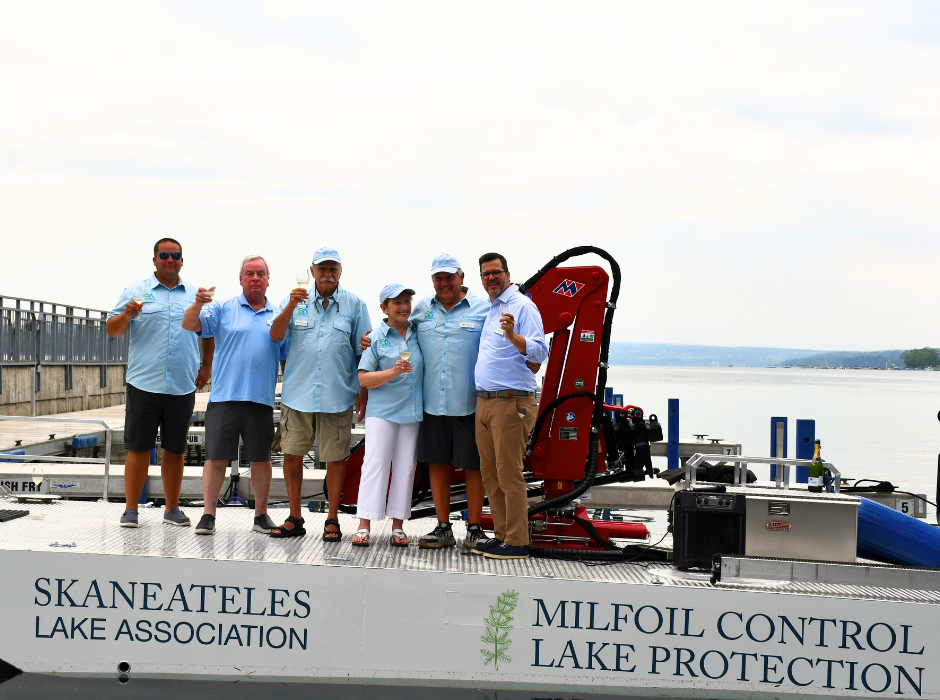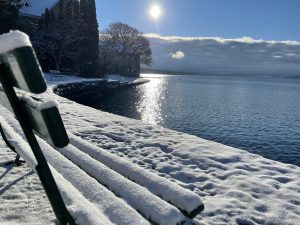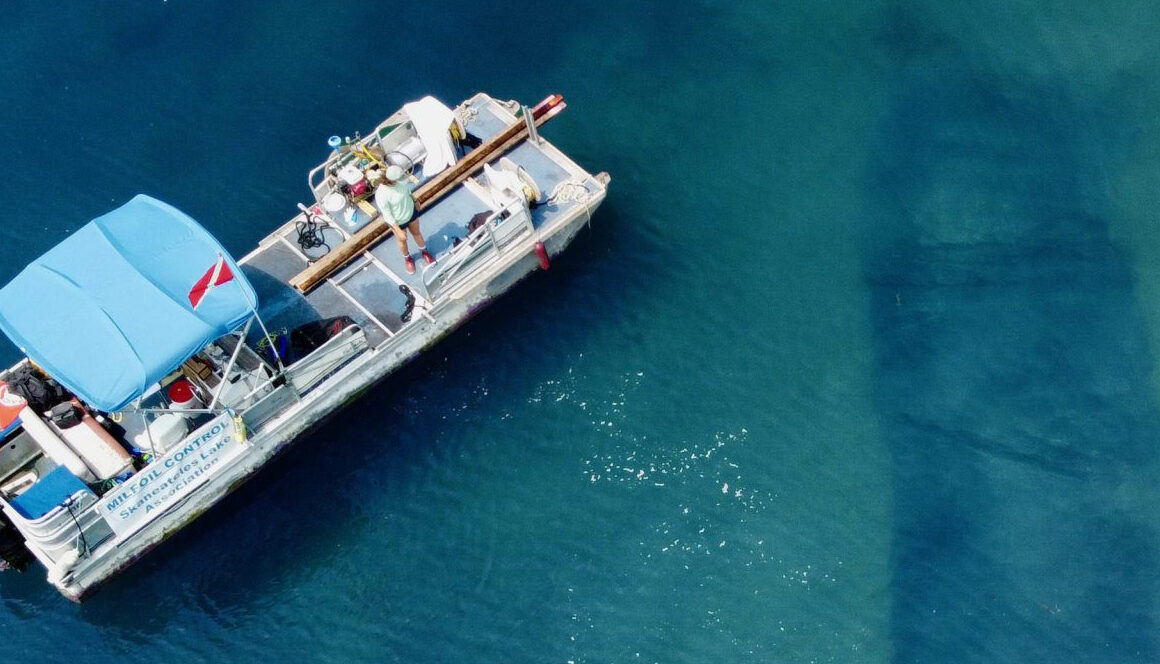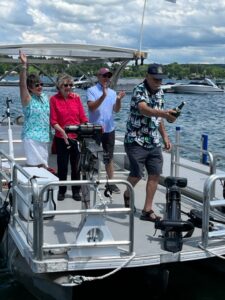
by Jason Gabak October 23, 2025 in News, Press-Observer
https://eaglenewsonline.com/new/2025/10/23/the-sla-celebrates-john-menapace/
submitted by Frank Moses, SLA Executive Director
Earlier this month, one of Skaneateles Lake’s fiercest defenders and protectors retired from the Skaneateles Lake Association’s (SLA) Milfoil Control Program.
Since this program’s inception in 2006, John Menapace, a long-time Skaneateles resident, and his company Aquatic Invasives, Inc., have successfully run the SLA’s milfoil control program.
So, in honor of his many contributions over the past 20 years, several board members and Frank Moses, SLA’s executive director, hosted a retirement luncheon for John and his wife Mary at the Sherwood Inn on Sept. 14.
At this luncheon, board members shared their favorite memories of Menapace’s tenure.
They also expressed their thanks and gratitude for his commitment to protecting the lake.
“Every lake homeowner, boater and swimmer who has enjoyed our lake over the past 20 years owes John and his team a huge debt of gratitude. They are true unsung heroes. Without his expertise, creativity and unique problem-solving skills, not to mention the incredibly skilled divers he recruited, managed and mentored, our lake would be overrun by this weed,” said Dana Hall, SLA’s president.
And the statistics bear this out.
Since 2012, each and every summer, Menapace and his team covered roughly six acres of milfoil growing along the lake’s shore.
That’s a total of more than 108 acres in 14 years.
To put that number in perspective, the Skaneateles Country Club has 61 acres.
Needless to say, that’s a lot of milfoil he and his team successfully killed off. And this total doesn’t include the milfoil they manually removed for the first five years of his tenure
“I have so enjoyed working with John over the past 14 years. He’s been a true partner and an ardent protector of this lake. Everyone in the Skaneateles Lake community needs to know and appreciate what he has done to keep our lake free of milfoil,” said Fran Rotunno-Fish, SLA board member and membership chair. “He will be so missed, but I am thrilled for he and Mary as they start their next chapter.”
Skaneateles’s history with milfoil
While milfoil was first detected in 1974, it did not become a concern until the late 1990s, when boaters and swimmers started noticing large patches near the Skaneateles Sailing Club and the village jetty.
A full-lake survey conducted in 2001 found 39 large patches of milfoil, but when that survey was repeated in 2006, the number had nearly tripled to 111 patches.
This explosive growth rate led to the establishment of the SLA that same year, with the late Dr. Robert Werner, a preeminent limnologist from ESF, leading the new non-profit’s efforts to mitigate milfoil’s spread.
It was Werner who partnered with Menapace and his company to devise a strategy to remove this invasive from the lake.
At the time, the established processes used to remove milfoil from nearby lakes included a weed harvesting machine on Otisco and Owasco, a milfoil-eating aquatic insect from Cornell University on Cayuga, and a strong herbicide used on Cazenovia Lake. Werner and Menapace determined none of these were ideal for Skaneateles Lake, especially the herbicide.
After further research and study, Menapace decided the best approach was to use divers who would pull the weeds out of the lake by hand. So, starting in the summer of 2006, after the SLA surveyed the lake and identified the largest patches of milfoil, Menapace and the divers “harvested” the weed, discarding the milfoil into large, 40-lb, repurposed onion bags and then bringing up the full bags to one of the six used pontoon boats Menapace purchased for this work. At its peak, there were nearly 30 divers harvesting the milfoil from the lakes bottom, which resulted in 100 bags being removed each day.
This approach, however, required the divers to be submerged for extended periods so Menapace came up with a solution: instead of relying on regular scuba tanks, he used “hose diving”. He purchased two compressors from a company in California and used them to pump oxygen down to the divers, which increased the divers’ productivity and efficiency.
Taking milfoil control to the next level
Not satisfied with their rate of removal, Menapace began investigating the efficacy of laying benthic mats over the patches of milfoil, which would kill the plant by depriving it of sunlight. Unhappy with the limited options available at the time, Menapace decided to design and fabricate his own mat.
He cut heavy-duty polyester fabric into pieces measuring between 40 and 50 feet by 12 feet. He then designed and built a special, 14-foot-wide sewing machine to sew in pockets every six feet, in which he could insert steel cable to weigh the mats down to the lake’s bottom. He made 325 of these mats by hand. This design was so successful that the same mats are still used today. In fact, this summer, just like every summer for the past 14 years, John and his team successfully placed and removed these mats, killing off another 6.3 acres of milfoil.
He also designed and built a custom mat roller, which is attached to the boat, to retrieve the mats from the lake bottom. The diving team lowers this hydraulically powered mechanism into the water to roll up the mats, which are then raised to the surface, detached and tied up for pick up later in the season.
“I mean think about what he’s accomplished. Without any industry expertise or experience, back in 2012 he designed and fabricated the very same mats we still use today. To fabricate them, he figured out how to retrofit an industrial-grade sewing machine to create the pockets for the cables that would keep the mats weighted to the lake floor,” said SLA board member Bob Dewitt. “He did the same for the roller mechanism. And he all this while being very mindful of our donors’ dollars. If that’s not ingenuity then I don’t know what is.”
When asked what made him the proudest about his 20-year tenure, Menapace revealed his true character, saying he hadn’t really thought about it.
He said, “It was a job that just had to be done. So we did it. Simple as that.”
And they did. But it was not a simple job. It required developing new ideas, new processes, and new machinery from scratch and then constantly improving these over the past 20 years. But the impressive results speak for themselves.









